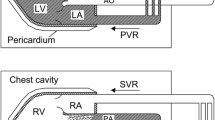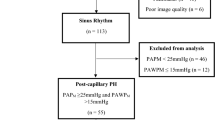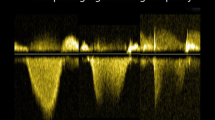Abstract
Pulmonary vascular resistance (PVR) is an important hemodynamic parameter in patients with heart failure, especially when the pulmonary arterial pressure is lower due to reduced stroke volume. Several echocardiographic methods to estimate PVR have been proposed, but their applications in patients with organic left-sided heart diseases have been limited. The aim of the present study was to examine the usefulness of our new method to estimate PVR (PVRPR) based on the continuous-wave Doppler velocity measurements of pulmonary regurgitation in these patients. In 43 patients who underwent right heart catheterization, PVRPR was calculated as the difference between the Doppler-derived early- and end-diastolic pulmonary artery (PA)-right ventricular (RV) pressure gradients divided by the cardiac output measured in the left ventricular outflow tract by echocardiography. The PVRPR correlated well with invasive PVR (PVRCATH) (r = 0.81, p < 0.001) without any fixed bias in Bland–Altman analysis. The conventional echocardiographic PVRs showed inadequate correlations with PVRCATH, or a obvious overestimation of PVRCATH. In the receiver operating characteristic analyses to determine the patients with abnormal elevation of PVRCATH (>3 Wood units, WU), the area under the curve was the greatest for PVRPR (0.964) compared to the conventional PVRs (0.649–0.839). PVRPR had 83 % sensitivity and 100 % specificity at the optimal cut-off value of 3.10 WU in identifying patients with PVRCATH >3 WU. Our simple and theoretical PVRPR is useful for the noninvasive estimation of PVR.




Similar content being viewed by others
References
Galiè N, Humbert M, Vachiery JL, Gibbs S, Lang I, Torbicki A, Simonneau G, Peacock A, Vonk Noordegraaf A, Beghetti M, Ghofrani A, Gomez Sanchez MA, Hansmann G, Klepetko W, Lancellotti P, Matucci M, McDonagh T, Pierard LA, Trindade PT, Zompatori M, Hoeper M, Aboyans V, Vaz Carneiro A, Achenbach S, Agewall S, Allanore Y, Asteggiano R, Paolo Badano L, Albert Barberà J, Bouvaist H, Bueno H, Byrne RA, Carerj S, Castro G, Erol Ç, Falk V, Funck-Brentano C, Gorenflo M, Granton J, Iung B, Kiely DG, Kirchhof P, Kjellstrom B, Landmesser U, Lekakis J, Lionis C, Lip GY, Orfanos SE, Park MH, Piepoli MF, Ponikowski P, Revel MP, Rigau D, Rosenkranz S, Völler H, Luis Zamorano J (2016) 2015 ESC/ERS Guidelines for the diagnosis and treatment of pulmonary hypertension: the Joint Task Force for the Diagnosis and Treatment of Pulmonary Hypertension of the European Society of Cardiology (ESC) and the European Respiratory Society (ERS): endorsed by: Association for European Paediatric and Congenital Cardiology (AEPC), International Society for Heart and Lung Transplantation (ISHLT). Eur Heart 37:67–119
Scapellato F, Temporelli PL, Eleuteri E, Corrà U, Imparato A, Gianuzzi P (2001) Accurate noninvasive estimation of pulmonary vascular resistance by Doppler echocardiography in patients with chronic heart failure. J Am Coll Cardiol 37:1813–1819
Abbas AE, Fortuin FD, Schiller NB, Appleton CP, Moreno CA, Lester SJ (2003) A simple method for noninvasive estimation of pulmonary vascular resistance. J Am Coll Cardiol 41:1021–1027
Dahiya A, Vollbon W, Jellis C, Prior D, Wahi S, Marwick T (2010) Echocardiographic assessment of raised pulmonary vascular resistance: application to diagnosis and follow-up of pulmonary hypertension. Heart 96:2005–2009
Lindqvist P, Söderberg S, Gonzalez MC, Tossavainen E, Henein MY (2011) Echocardiography based estimation of pulmonary vascular resistance in patients with pulmonary hypertension: a simultaneous Doppler echocardiography and cardiac catheterization study. Eur J Echocardiogr 12:961–966
Abbas AE, Franey LM, Marwick T, Maeder MT, Kaye DM, Vlahos AP, Serra W, Al-Azizi K, Schiller NB, Lester SJ (2013) Noninvasive assessment of pulmonary vascular resistance by Doppler echocardiography. J Am Soc Echocardiogr 26:1170–1177
Milan A, Magnino C, Veglio F (2010) Echocardiographic indexes for the non-invasive evaluation of pulmonary hemodynamics. J Am Soc Echocardiogr 23:225–239
Rudski LG, Lai WW, Afilalo J, Hua L, Handschumacher MD, Chandrasekaran K, Solomon SD, Louie EK, Schiller NB (2010) Guidelines for the echocardiographic assessment of the right heart in adults: a report from the American Society of Echocardiography endorsed by the European Association of Echocardiography, a registered branch of the European Society of Cardiology, and the Canadian Society of Echocardiography. J Am Soc Echocardiogr 23:685–713
Nagueh SF, Appleton CP, Gillebert TC, Marino PN, Oh JK, Smiseth OA, Waggoner AD, Flachskampf FA, Pellikka PA, Evangelista A (2009) Recommendations for the evaluation of left ventricular diastolic function by echocardiography. J Am Soc Echocardiogr 22:107–133
Lee RT, Lord CP, Plappert T, Sutton MS (1989) Prospective Doppler echocardiographic evaluation of pulmonary artery diastolic pressure in the medical intensive care unit. Am J Cardiol 64:1366–1370
Lang RM, Badano LP, Mor-Avi V, Afilalo J, Armstrong A, Ernande L, Flachskampf FA, Foster E, Goldstein SA, Kuznetsova T, Lancellotti P, Muraru D, Picard MH, Rietzschel ER, Rudski L, Spencer KT, Tsang W, Voigt JU (2015) Recommendations for cardiac chamber quantification by echocardiography in adults: an update from the American Society of Echocardiography and the European Association of Cardiovascular Imaging. J Am Soc Echocardiogr 28:1–39
Bland JM, Altman DG (1986) Statistical methods for assessing agreement between two methods of clinical measurement. Lancet 1:307–310
Geske JB, Sorajja P, Nishimura RA, Ommen SR (2007) Evaluation of left ventricular filling pressures by Doppler echocardiography in patients with hypertrophic cardiomyopathy: correlation with direct left atrial pressure measurement at cardiac catheterization. Circulation 116:2702–2708
Mullens W, Borowski AG, Curtin RJ, Thomas JD, Tang WH (2009) Tissue Doppler imaging in the estimation of intracardiac filling pressure in decompensated patients with advanced systolic heart failure. Circulation 119:62–70
Borgeson DD, Seward JB, Miller FA Jr, Oh JK, Tajik AJ (1996) Frequency of Doppler measurable pulmonary artery pressures. J Am Soc Echocardiogr 9:832–837
Tei C, Pilgrim JP, Shah PM, Ormiston JA, Wong M (1982) The tricuspid valve annulus: study of size and motion in normal subjects and in patients with tricuspid regurgitation. Circulation 66:665–671
Mikami T, Kudo T, Sakurai N, Sakamoto S, Tanabe Y, Yasuda H (1984) Mechanisms for development of functional tricuspid regurgitation determined by pulsed Doppler and two-dimensional echocardiography. Am J Cardiol 53:160–163
Minagoe S, Rahimtoola SH, Chandraratna PA (1990) Significance of laminar systolic regurgitant flow in patients with tricuspid regurgitation: a combined pulsed-wave, continuous-wave Doppler and two-dimensional echocardiographic study. Am Heart J 119:627–635
Cobey FC, Fritock M, Lombard FW, Glower DD, Swaminathan M (2012) Severe tricuspid valve regurgitation: a case for laminar flow. J Cardiothorac Vasc Anesth 26:522–524
Davidson CJ, Bonow RO (2012) Cardiac catheterization. In: Bonow RO, Mann DL, Zipes DP, Libby P (eds) Braunwald’s Heart Disease, 9th edn. Elsevier Saunders, Philadelphia, pp 383–405
Author information
Authors and Affiliations
Corresponding author
Ethics declarations
Conflict of interest
None to declare.
Rights and permissions
About this article
Cite this article
Kaga, S., Mikami, T., Murayama, M. et al. A new method to estimate pulmonary vascular resistance using diastolic pulmonary artery-right ventricular pressure gradients derived from continuous-wave Doppler velocity measurements of pulmonary regurgitation. Int J Cardiovasc Imaging 33, 31–38 (2017). https://doi.org/10.1007/s10554-016-0965-2
Received:
Accepted:
Published:
Issue Date:
DOI: https://doi.org/10.1007/s10554-016-0965-2




